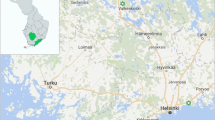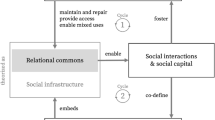Abstract
Despite the acknowledged importance of the meanings that people attach to places (e.g., homes, businesses, communities), the literature on cross-sector partnerships (CSPs) provides few insights into how place influences CSPs and how CSPs influence the places where they are enacted. To address this oversight, we explore the role of place using an inductive comparative study of nine CSPs, split across five rural cooperative enterprises and four urban social enterprises that have a common private-sector partner. We inductively derive a process model of place renewal that occurs through CSP growth, and changes the meanings that individuals give to their places. We utilize Penrose’s theory of firm growth to explain how rural CSPs grew in different ways than urban CSPs, and the changed meanings of place that emerged. Both rural and urban CSPs overcome initial perceived restrictions of place through a process of realizing the potential for change, reconfiguring the organization through physical and process changes, and ultimately experiencing renewal that changes how they view their places. Our study contributes to the CSP literature by acknowledging the role of place in theorizing on CSPs, and by including the agency and voice of traditionally marginalized actors in the CSP process. It also contributes to the theory of firm growth by explicitly incorporating place as an outcome of the organizational growth process.

Similar content being viewed by others
Data availability
The participants of this study did not give written consent for their data to be shared publicly, so due to the sensitive nature of the research supporting data is not available.
Change history
03 April 2023
The original version of this article was revised: In this article the affiliation details for Authors Todd W. Moss and Suho Han were incorrect. The original article has been corrected.
03 April 2023
A Correction to this paper has been published: https://doi.org/10.1007/s10551-023-05403-2
References
Agnew, J. A. (1987). Place and politics: The geographical mediation of state and society. Allen & Unwin.
Aguinis, H., & Glavas, A. (2012). What we know and don’t know about corporate social responsibility: A review and research agenda. Journal of Management, 38(4), 932–968.
Arenas, D., Murphy, M., & Jáuregui, K. (2019). Community influence capacity on firms: Lessons from the Peruvian highlands. Organization Studies, 41(6), 737–765.
Bitzer, V., & Glasbergen, P. (2010). Partnerships for sustainable change in cotton: An institutional analysis of African cases. Journal of Business Ethics, 93(2), 223–240.
Bryson, J. M., Crosby, B. C., & Stone, M. M. (2015). Designing and implementing cross-sector collaborations: Needed and challenging. Public Administration Review, 75(5), 647–663.
Clarke, A., & MacDonald, A. (2019). Outcomes to partners in multi-stakeholder cross-sector partnerships: A resource-based view. Business & Society, 58(2), 298–332.
CONEVAL. (2018). Poverty of the indigenous population in Mexico, 2018. Retrieved November 10, 2021, from https://www.coneval.org.mx/Medicion/MP/Paginas/Pobreza_Indigena.aspx.
Cresswell, T. (2004). Place: A short introduction (pp. 1–14). Blackwell.
Dentoni, D., Bitzer, V., & Pascucci, S. (2016). Cross-sector partnerships and the co-creation of dynamic capabilities for stakeholder orientation. Journal of Business Ethics, 135(1), 35–53.
Eisenhardt, K. M. (1989). Building theories from case study research. Academy of Management Review, 14(4), 532–550.
Eisenhardt, K. M., & Graebner, M. E. (2007). Theory building from cases: Opportunities and challenges. Academy of Management Journal, 50(1), 25–32.
George, J., & Jones, G. (2000). The role of time in theory and theory building. Journal of Management, 26(4), 657–684.
Gieryn, T. F. (2000). A space for place in sociology. Annual Review of Sociology, 26(1), 463–496.
Gioia, D. A., Corley, K. G., & Hamilton, A. L. (2013). Seeking qualitative rigor in inductive research notes on the gioia methodology. Organizational Research Methods, 16(1), 15–31.
Gond, J. P., & Nyberg, D. (2017). Materializing power to recover corporate social responsibility. Organization Studies, 38(8), 1127–1148.
Hay, R. (1998). Sense of place in a developmental context. Journal of Environmental Psychology, 18(1), 5–29.
INEGI. (2020). Rural and urban population. Retrieved November 4, 2020, from http://cuentame.inegi.org.mx/poblacion/rur_urb.aspx?tema_P.
Julian, S. D., & Castrogiovanni, G. J. (1995). Franchisor geographic expansion. Journal of Small Business Management, 33(2), 1–11.
Kolk, A., & Lenfant, F. (2010). MNC reporting on CSR and conflict in Central Africa. Journal of Business Ethics, 93(2), 241–255.
Kolk, A., & Lenfant, F. (2015). Cross-sector collaboration, institutional gaps, and fragility: The role of social innovation partnerships in a conflict-affected region. Journal of Public Policy & Marketing, 34(2), 287–303.
Kolk, A., van Dolen, W., & Vock, M. (2010). Trickle effects of cross-sector social partnerships. Journal of Business Ethics, 94(1), 123–137.
Kyle, G., & Chick, G. (2007). The social construction of a sense of place. Leisure Sciences, 29(3), 209–225.
Le Ber, M. J., & Branzei, O. (2010). Towards a critical theory of value creation in cross-sector partnerships. Organization, 17(5), 599–629.
Lepak, D. P., Smith, K. G., & Taylor, M. S. (2007). Value creation and value capture: A multilevel perspective. Academy of Management Review, 32(1), 180–194.
Lewicka, M. (2011). Place attachment: How far have we come in the last 40 years? Journal of Environmental Psychology, 31(3), 207–230.
Lin, H. (2012). Cross-sector alliances for corporate social responsibility partner heterogeneity moderates environmental strategy outcomes. Journal of Business Ethics, 110(2), 219–229.
Lin, H., & Darnall, N. (2015). Strategic alliance formation and structural configuration. Journal of Business Ethics, 127(3), 549–564.
Lincoln, Y. S., & Guba, E. G. (1985). Naturalistic inquiry. Sage Publications.
Marti, I., Courpasson, D., & Dubard Barbosa, S. (2013). “Living in the fishbowl”. Generating an entrepreneurial culture in a local community in Argentina. Journal of Business Venturing, 28(1), 10–29.
McKeever, E., Jack, S., & Anderson, A. (2015). Embedded entrepreneurship in the creative re-construction of place. Journal of Business Venturing, 30(1), 50–65.
McKelvie, A., & Wiklund, J. (2010). Advancing firm growth: A focus on growth mode instead of growth rate. Entrepreneurship Theory & Practice, 34(2), 261–288.
Mexico. (1961). Constitution of the United Mexican States. 1917 (as amended). Pan American Union.
Moss, T. W., Dahik Loor, A. C., & Diaz Parada, F. (2022). Partnerships as an enabler of resourcefulness in generating sustainable outcomes. Journal of Business Venturing, 37(1), 106089. https://doi.org/10.1016/j.jbusvent.2020.106089
Murphy, M., & Arenas, D. (2010). Through indigenous lenses: Cross-sector collaborations with fringe stakeholders. Journal of Business Ethics, 94(1), 103–121.
Nason, R., & Wiklund, J. (2018). As assessment of resource-based theorizing on firm growth and suggestions for the future. Journal of Management, 44(1), 32–60.
Ornelas, P. V. (2018). Rural poverty in Mexico: prevalence and challenges. National Council for the Evaluation of Social Development Policy Expert Meeting, 10. Retrieved November 10, 2021, from www.coneval.org.mx.mx.
Penrose, E. T. (1959). The theory of the growth of the firm. Oxford University Press.
Penrose, E. T. (1960). The growth of the firm—a case study: Hercules powder corporation. The Business History Review, 34(1), 1–23.
Quélin, B. V., Kivleniece, I., & Lazzarini, S. (2017). Public-private collaboration, hybridity and social value: Towards new theoretical perspectives. Journal of Management Studies, 54(6), 763–792.
Rangan, S., Samii, R., & Van Wassenhove, L. N. (2006). Constructive partnerships: When alliances between private firms and public actors can enable creative strategies. AcAdemy of Management Review, 31(3), 738–751.
Rein, M., & Stott, L. (2009). Working together: Critical perspectives on six cross-sector partnerships in southern Africa. Journal of Business Ethics, 90(1), 79–89.
Sawyer, S. & Gomez, E. T. (2008). Transnational governmentality and resource extraction, identities, conflict and cohesion programme, Technical report,UN- RISD, Geneva.
Selsky, J. W., & Parker, B. (2005). Cross-sector partnerships to address social issues: Challenges to theory and practice. Journal of Management, 31(6), 849–873.
Shane, S. A. (1996). Hybrid organizational arrangements and their implications for firm growth and survival: A study of new franchisors. Academy of Management Journal, 39(1), 216–234.
Shepherd, D., & Wiklund, J. (2009). Are we comparing apples with apples or apples with oranges? Appropriateness of knowledge accumulation across growth studies. Entrepreneurship Theory & Practice, 33(1), 105–123.
Smith, D. M. (2007). Moral aspects of place. Planning Theory, 6(1), 7–15.
Strauss, A., & Corbin, J. (1998). Basics of qualitative research: Techniques and procedures for developing grounded theory (2nd ed.). Sage Publications.
van Tulder, R., Seitanidi, M. M., Crane, A., & Brammer, S. (2016). Enhancing the impact of cross-sector partnerships: Four impact loops for channeling partnership studies. Journal of Business Ethics, 135(1), 1–17.
Whetten, D. (1989). What constitutes a theoretical contribution? Academy of Management Review, 14(4), 490–495.
Williamson, O. E. (1991). Comparative economic organization: The analysis of discrete structural alternatives. Administrative Science Quarterly, 36(2), 269–296.
Acknowledgements
The authors gratefully acknowledge the helpful comments and feedback from the guest editorial team and anonymous reviewers. They thank Fabian Díaz Parada for his valuable support in the data collection process. They also acknowledge with thanks the financial support of the Whitman School of Management at Syracuse University and IPADE Business School.
Author information
Authors and Affiliations
Corresponding author
Additional information
Publisher's Note
Springer Nature remains neutral with regard to jurisdictional claims in published maps and institutional affiliations.
The original version of this article was revised: In this article the affiliation details for Authors Todd W. Moss and Suho Han were incorrect. The original article has been corrected.
Supplementary Information
Below is the link to the electronic supplementary material.
Rights and permissions
Springer Nature or its licensor (e.g. a society or other partner) holds exclusive rights to this article under a publishing agreement with the author(s) or other rightsholder(s); author self-archiving of the accepted manuscript version of this article is solely governed by the terms of such publishing agreement and applicable law.
About this article
Cite this article
Loor, A.C.D., Moss, T.W. & Han, S. Rural and Urban Place Renewal in Cross-Sector Partnerships. J Bus Ethics 184, 793–812 (2023). https://doi.org/10.1007/s10551-023-05366-4
Received:
Accepted:
Published:
Issue Date:
DOI: https://doi.org/10.1007/s10551-023-05366-4




